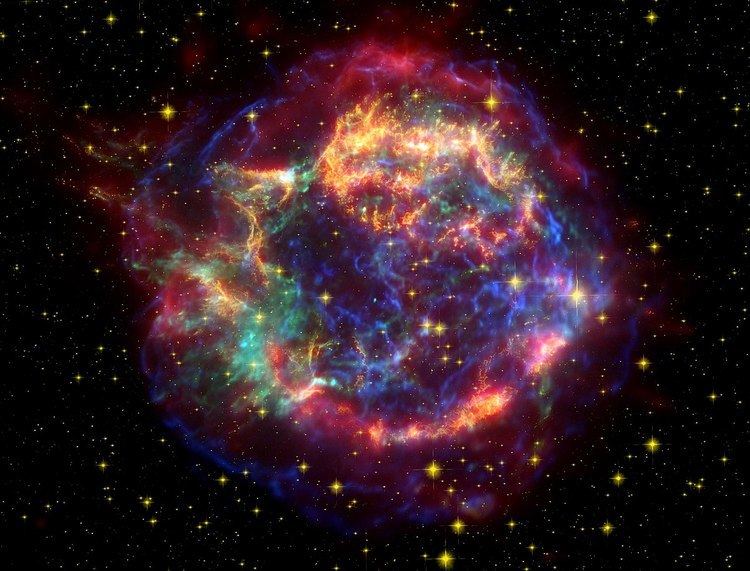Spectral class IIb | Date 1947 Right ascension 23 23 26 | |
 | ||
Other designations SN 1671, SN 1667, SN 1680, SNR G111.7-02.1, 1ES 2321+58.5 Event type Supernova remnant, astronomical radio source | ||
Cassiopeia A (Cas A) is a supernova remnant (SNR) in the constellation Cassiopeia and the brightest extrasolar radio source in the sky at frequencies above 1 GHz. The supernova occurred approximately 11,000 light-years (3.4 kpc) away within the Milky Way. The expanding cloud of material left over from the supernova now appears approximately 10 light-years (3 pc) across from Earth's perspective. In wavelengths of visible light, it has been seen with amateur telescopes down to 234mm (9.25 in) with filters.
Contents
- Earlier discovery
- Expansion
- Radio source
- X ray source
- Supernova reflected echo
- Phosphorus detection
- References
It is believed that first light from the stellar explosion reached Earth approximately 300 years ago but there are no historical records of any sightings of the supernova that created the remnant, probably due to interstellar dust absorbing optical wavelength radiation before it reached Earth (although it is possible that it was recorded as a sixth magnitude star 3 Cassiopeiae by John Flamsteed on August 16, 1680). Possible explanations lean toward the idea that the source star was unusually massive and had previously ejected much of its outer layers. These outer layers would have cloaked the star and re-absorbed much of the light released as the inner star collapsed.
Cas A was among the first discrete astronomical radio sources found. Its discovery was reported in 1948 by Martin Ryle and Francis Graham-Smith, astronomers at Cambridge, based on observations with the Long Michelson Interferometer. The optical component was first identified in 1950.
Cas A is 3C461 in the Third Cambridge Catalogue of Radio Sources and G111.7-2.1 in the Green Catalog of Supernova Remnants.
Earlier discovery
Calculations working back from the currently observed expansion point to an explosion that would have become visible on Earth around 1667. Astronomer William Ashworth and others have suggested that the Astronomer Royal John Flamsteed may have inadvertently observed the supernova on August 16, 1680, when he catalogued a star near its position. Another suggestion from recent cross-disciplinary research is that the supernova was the mythical "noon day star", observed in 1630, that heralded the birth of Charles II, the future monarch of Great Britain. At any rate, no supernova occurring within the Milky Way has been visible to the naked eye from Earth since.
Expansion
The expansion shell has a temperature of around 50 million degrees Fahrenheit (30 megakelvins), and is expanding at 4000−6000 km/s.
Observations of the exploded star through the Hubble telescope have shown that, despite the original belief that the remnants were expanding in a uniform manner, there are high velocity outlying eject knots moving with transverse velocities of 5,500−14,500 km/s with the highest speeds occurring in two nearly opposing jets. When the view of the expanding star uses colors to differentiate materials of different chemical compositions, it shows that similar materials often remain gathered together in the remnants of the explosion.
Radio source
Cas A had a flux density of 2720 ± 50 Jy at 1 GHz in 1980. Because the supernova remnant is cooling, its flux density is decreasing. At 1 GHz, its flux density is decreasing at a rate of 0.97 ± 0.04 percent per year. This decrease means that, at frequencies below 1 GHz, Cas A is now less intense than Cygnus A. Cas A is still the brightest extrasolar radio source in the sky at frequencies above 1 GHz.
X-ray source
In 1979, Shklovsky predicted that Cas A had a black hole. In 1999, the Chandra X-Ray Observatory found a "hot point-like source" close to the center of the nebula that is quite likely the neutron star or black hole predicted but not previously found.
Although Cas X-1 (or Cas XR-1), the apparent first X-ray source in the constellation Cassiopeia was not detected during the June 16, 1964, Aerobee sounding rocket flight, it was considered as a possible source. Cas A was scanned during another Aerobee rocket flight of October 1, 1964, but no significant X-ray flux above background was associated with the position. Cas XR-1 was discovered by an Aerobee rocket flight on April 25, 1965, at RA 23h 21m Dec +58° 30′. Cas X-1 is Cas A, a Type II SNR at RA 23h 18m Dec +58° 30′.
The designations Cassiopeia X-1, Cas XR-1, Cas X-1 are no longer used, but the X-ray source is Cas A (SNR G111.7-02.1) at 2U 2321+58.
Supernova reflected echo
Recently, an infrared echo of the Cassiopeia A explosion was observed on nearby gas clouds using Spitzer Space Telescope. The recorded spectrum proved the supernova was of Type IIb, meaning it resulted from the internal collapse and violent explosion of a massive star, most probably a red supergiant with a helium core which had lost almost all of its hydrogen envelope. This was the first observation of the infrared echo of a supernova whose explosion had not been directly observed which opens up the possibility of studying and reconstructing past astronomical events.
Phosphorus detection
In 2013, astronomers detected phosphorus in Cassiopeia A, which confirmed that this element is produced in supernovae through supernova nucleosynthesis. The phosphorus-to-iron ratio in material from the supernova remnant could be up to 100 times higher than in the Milky Way in general.
